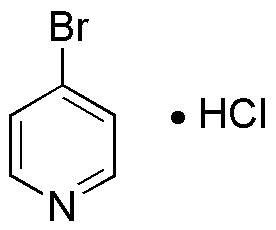4-Bromopyridine hydrochloride is widely utilized in research focused on:
- Synthesis of Pharmaceuticals: This compound serves as a key intermediate in the synthesis of various pharmaceutical agents, particularly those targeting neurological disorders, enhancing drug development processes.
- Agricultural Chemicals: It is used in the formulation of agrochemicals, contributing to the development of effective pesticides and herbicides that help improve crop yields and protect against pests.
- Material Science: The compound is employed in creating specialized polymers and materials, offering unique properties that enhance the performance of coatings and adhesives.
- Research Reagents: As a reagent in organic synthesis, it aids researchers in developing new chemical reactions, facilitating advancements in chemical research and innovation.
- Biochemical Applications: It is utilized in studying enzyme activities and interactions, providing insights into biochemical pathways and aiding in the discovery of new therapeutic targets.
General Information
Properties
Safety and Regulations
Applications
4-Bromopyridine hydrochloride is widely utilized in research focused on:
- Synthesis of Pharmaceuticals: This compound serves as a key intermediate in the synthesis of various pharmaceutical agents, particularly those targeting neurological disorders, enhancing drug development processes.
- Agricultural Chemicals: It is used in the formulation of agrochemicals, contributing to the development of effective pesticides and herbicides that help improve crop yields and protect against pests.
- Material Science: The compound is employed in creating specialized polymers and materials, offering unique properties that enhance the performance of coatings and adhesives.
- Research Reagents: As a reagent in organic synthesis, it aids researchers in developing new chemical reactions, facilitating advancements in chemical research and innovation.
- Biochemical Applications: It is utilized in studying enzyme activities and interactions, providing insights into biochemical pathways and aiding in the discovery of new therapeutic targets.
Documents
Safety Data Sheets (SDS)
The SDS provides comprehensive safety information on handling, storage, and disposal of the product.
Product Specification (PS)
The PS provides a comprehensive breakdown of the product’s properties, including chemical composition, physical state, purity, and storage requirements. It also details acceptable quality ranges and the product's intended applications.
Certificates of Analysis (COA)
Search for Certificates of Analysis (COA) by entering the products Lot Number. Lot and Batch Numbers can be found on a product’s label following the words ‘Lot’ or ‘Batch’.
Numéro de catalogue
Numéro de lot/série
Certificates Of Origin (COO)
This COO confirms the country where the product was manufactured, and also details the materials and components used in it and whether it is derived from natural, synthetic, or other specific sources. This certificate may be required for customs, trade, and regulatory compliance.
Numéro de catalogue
Numéro de lot/série
Safety Data Sheets (SDS)
The SDS provides comprehensive safety information on handling, storage, and disposal of the product.
DownloadProduct Specification (PS)
The PS provides a comprehensive breakdown of the product’s properties, including chemical composition, physical state, purity, and storage requirements. It also details acceptable quality ranges and the product's intended applications.
DownloadCertificates of Analysis (COA)
Search for Certificates of Analysis (COA) by entering the products Lot Number. Lot and Batch Numbers can be found on a product’s label following the words ‘Lot’ or ‘Batch’.
Numéro de catalogue
Numéro de lot/série
Certificates Of Origin (COO)
This COO confirms the country where the product was manufactured, and also details the materials and components used in it and whether it is derived from natural, synthetic, or other specific sources. This certificate may be required for customs, trade, and regulatory compliance.


